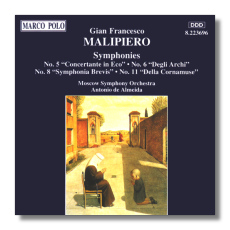
The Internet's Premier Classical Music Source
Related Links
- Latest Reviews
- More Reviews
-
By Composer
-
Collections
DVD & Blu-ray
Books
Concert Reviews
Articles/Interviews
Software
Audio
Search Amazon
Recommended Links
Site News
 CD Review
CD Review
Gian Francesco Malipiero

Symphonies
- Symphony #5, "Concerto in eco"
- Symphony #6, "Degli archi"
- Symphony #8, "Symphonia brevis"
- Symphony #11, "Della cornamusa"
Moscow Symphony Orchestra/Antonio de Almeida
Marco Polo 8.223696 DDD 73:45
Produced by Edvard Shakhnazazian


- Symphony #9, "dell'ahimè"
- Symphony #10, "Atropo"
- Sinfonia della zodiaco
Moscow Symphony Orchestra/Antonio de Almeida
Marco Polo 8.223697 DDD 61:17
Produced by Edvard Shakhnazazian
Writing elsewhere (shame on me), I gave the first three instalments of Marco Polo's path-breaking series of Malipiero Symphonies a rather guarded welcome (#1 and 2 and the Sinfonia del silenzio e de la morte on 8.223603, #3 and 4 and the Sinfonia del mare on 8.223602, and #7, "delle canzoni", the Sinfonia in un tempo and Sinfonia per Antigenida on 8.223604). Here was music that is well made, full of original effects, but that was not particularly symphonic, nor did it display much of a harmonic soul. I am afraid that I have to give the same hesitant welcome - but a welcome nonetheless - to the two discs that close the series, containing the last seven of the seventeen works in Malipiero's vast catalogue that contain the word "sinfonia" in their title. John Waterhouse, the Malipiero expert, whose notes accompany each of these discs (every instance a model of scholarly informativeness), warns in one of these essays that these pieces are "hardly 'symphonic' in the normally understood sense: far from embodying close-knit thematic and tonal arguments, Malipiero's symphonies tend to be willfully free and unpredictable in their sequences of events and images." He goes on to quote Malipiero to the effect that "the Italian symphony [sinfonia ] is a free kind of poem in several parts which follow one another capriciously, obeying only those mysterious laws that instinct recognises." And that's just what you get.
The first of these two discs opens with the Sixth Symphony of 1947, subtitled "degli archi", which is, as one might expect, scored for strings only, and is followed by #5, composed earlier that year. Without a sense of symphonic momentum, the Sixth strikes these ears as at best a suite for strings, intriguing but not convincing (though this is the most frequently played of Malipiero's Symphonies). So when the two orchestral pianos of #5, which bears the subtitle "Concertante in eco", burst in afterwards, full of contrapuntal purpose, I sat up and took notice: this is music that is going somewhere. The language is also tighter and more purposeful than in #6. Unfortunately, this sense of drive doesn't last (the movement, indeed, is over in under four minutes), and the three following movements are more aimlessly convivial in mood, though occasionally enlivened by more abrasive sections (recalling Havergal Brian at the beginning of the Scherzo, though it's highly unlikely that he knew any of Brian's music)
The Eighth and Eleventh Symphonies, subtitled respectively the "Symphonia Brevis" (though it's longer than most of the later Symphonies) and "Della cornamuse" ("Of the bagpipe"), are in a much tougher, tonally ambiguous language (they date from 1964 and 1969, when Malipiero was into his eighties). Paradoxically, this harmonic freedom also liberates his counterpoint: instead of imaging what Malipiero could have done, where he could have gone, with a better disciplined sense of tonal direction, you listen to the moment in hand, admiring the idiosyncrasy of the polyphony without being distracted by a lack of structural purpose.
The same is true of the Ninth and Tenth Symphonies - "dell'ahimè" ("Of the Alas") and "Atropo" (a reference to one of the Fates in classical mythology) - of 1966 and '67. They're tightly written (by Malipiero's standards), persuasive works. Not so the forty-minute Sinfonia dello Zodiaco of 1951, which overstays its welcome. It's in twelve brief and aimless movements, split into four Partite of three apiece. But there seems to be little attempt to portray astrological characteristics in the music - indeed, most of Malipiero's off-beat subtitles don't really help you in listening to the music. Perhaps the solution to the problem in live performance would be to play individual Partite in isolation, if the opportunity ever came; after all, there's no symphonic argument to damage.
Antonio de Almeida gets playing from the Moscow Symphony Orchestra that is only just up to the mark. The string intonation is pretty duff at times, and indeed Almeida's direction is fairly lackadaisical: you don't have to know the music (and who does, bar Dr. Waterhouse?) to hear how much more punch these scores could reveal. That said, no one with an interest in twentieth-century music can afford to ignore these releases. If you want to dip your toes before going the whole hog of all five CDs, perhaps the disc to begin with is the one with Symphonies #5, 6, 8 and 11.
Copyright © 1996/1998, Martin Anderson


















